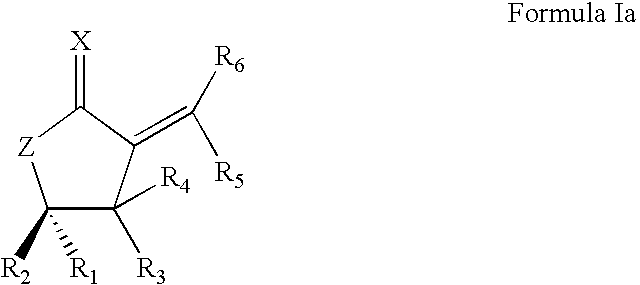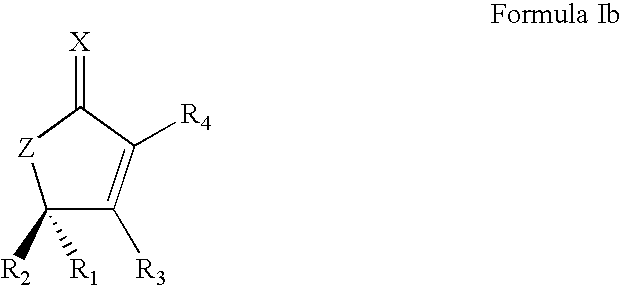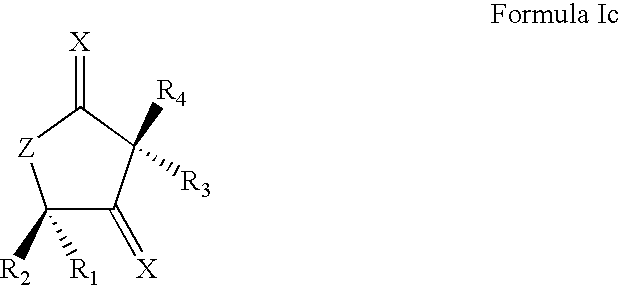Synthetic Lactone Formulations and Methods of Use
a technology of synthetic lactone and formulation, applied in the field of pharmaceutically active lactone, can solve the problems of hair loss, nausea, vomiting, suppression of bone marrow function, and many negative side effects of chemotherapeutic agents, and achieve the effect of effective treatment or prevention and effective treatment or prevention
- Summary
- Abstract
- Description
- Claims
- Application Information
AI Technical Summary
Benefits of technology
Problems solved by technology
Method used
Image
Examples
example 1
Microbiological Sensitivity Assays
[0060]Culture Medium:
[0061]Solvent: Buffer Phosphate 0.1N pH=8.0
[0062]Antibiotic: LMSV-6 (Securolide):
[0063]Medium coat: 2 mL / 100 mL of Medium
[0064]Inoculum: 4 mL / Petri Dish
[0065]Preparation of Culture Medium:[0066]Culture Medium for Staphylococo aureus (USP 23 )[0067]Peptone . . . 1.0 g[0068]Digestive pancreatic Caseine . . . 4.0 g[0069]Yeast Extract . . . 3.0 g[0070]Beef Extract . . . 1.5 g[0071]Dextrose . . . 1.0 g[0072]Agar . . . 15.0 g[0073]Water to make about . . . 1.0 Lit[0074]pH after sterilized 6.6±0.1[0075]Culture Medium for Pseudomona aeruginosa (USP 23 )[0076]Pancreatic digestive Caseine . . . 17.0 g[0077]soy Papaine digestive . . . 3.0 g[0078]Sodium Chloride . . . 5.0 g[0079]Dibasic Potassium Phosphate . . . 2.5 g[0080]Dextrose . . . 2.5 g[0081]Agar . . . 20.0 g[0082]Water to make about . . . 1.0 Lit[0083]pH after sterilized 7.2±0.1[0084]Culture Medium for E. coli and k. neumoniae (according to USP 23 )[0085]Peptone . . . 5.0 g[0086]Yea...
example 2
Determination of Anti-Fungal Activity
Materials and Methods:
[0123]Female mice weighing 18 to 22 g were used and a quantity of Candida Albicans 44858 was administered into a vein in the tail at the rate of 106 CFU per mouse (CFU: colony forming unit). The mice were separated into 5 batches of 5 mice and they were treated in the following manner:
One Hour After Infection
[0124]group 1: the mice were treated with product at 25 mg / kg orally,
[0125]group 2: the mice were treated with product intraperitoneally at the dose of 25 mg / kg,
[0126]group 3: the mice were treated orally with Ketoconazole at 25 mg / kg,
[0127]group 4: the mice were treated intraperitoneally with Ketoconazole at a dose of 25 mg / kg,
[0128]group 5: the mice did not receive any anti-fungal treatment.
The dead mice were counted over a period of 22 days.
Results and Discussion
[0129]The activity of product was excellent at the dose used in the two administration methods. The same treatments were also effective in the “topical model”...
example 3
Cytotoxicity or Antineoplasticity Assays
[0135]Quantitation of the antiproliferative and cytotoxic effects of drugs can be performed using the tetrazolium salt, MTT (3-(4,5-dimethylthiazol-2-yl)-2,5-diphenyl tetrazolium bromide). In this colorimetric assay, the yellow tetrazolium salt, NT, is cleaved into purple formazan by the mitochondrial enzyme, Succinate-Dehydrogenase, only in living cells. Formazan accumulates within the viable cells because it is impermeable to the cell membrane. The amount of formazan produced is proportional to the amount of living cells following drug treatment. This assay was used to detect the cytotoxic or antineoplastic effects of our compound against a number of cancer cell lines.
[0136]Former methods utilize well known tissue culture techniques using various cancer cell lines, e.g. HEP-2(Laryngeal carcinoma), HELA (Cervix Carcinoma). The Formazan concentration is measured in a gradient of Securolide concentrations by multi-well scanning spectrophotomete...
PUM
 Login to View More
Login to View More Abstract
Description
Claims
Application Information
 Login to View More
Login to View More - R&D
- Intellectual Property
- Life Sciences
- Materials
- Tech Scout
- Unparalleled Data Quality
- Higher Quality Content
- 60% Fewer Hallucinations
Browse by: Latest US Patents, China's latest patents, Technical Efficacy Thesaurus, Application Domain, Technology Topic, Popular Technical Reports.
© 2025 PatSnap. All rights reserved.Legal|Privacy policy|Modern Slavery Act Transparency Statement|Sitemap|About US| Contact US: help@patsnap.com



